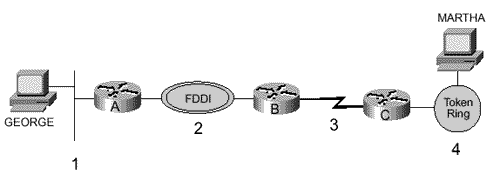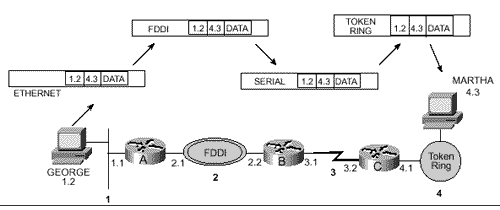Network Addresses
| Note Each member network in a routed internetwork requires a unique identifier. For devices to correctly communicate on a LAN, they must be uniquely identified by means of a data link identifier. If a routed internetwork ”a network of networks ”is to be created, then each member network must likewise be uniquely identifiable. Note Network address The most fundamental criterion for a routed internetwork is that for a router to correctly deliver packets to their proper destination, each and every network, or data link, must be uniquely identified. Providing this unique identification is the purpose of a network address . Figure 1.10 suggests a type of network address. Notice that every network has its own unique address. Notice also that the point-to-point serial link has an address. A common mistake that beginners make is to forget that serial links are also networks and therefore require their own addresses for routing to work. Figure 1.10. Each network must have a uniquely identifiable address. Now one of the two questions posed at the end of the last section can be answered : The routers can deliver the packet because the originating host put a destination address in the packet. From the perspective of the router, the destination address is all that is needed. As a rule, all routers really care about is the location of each network. Individual devices are not relevant to the router; the router only needs to deliver the packet to the correct destination network. When the packet arrives at the network, the data link identifier can be used to deliver the data to the individual device on the network. Note The fundamental purpose and function of a router How routers handle destination addresses is critically important and bears repeating. The purpose of a router is to deliver packets to the proper destination networks. As such, the only individual devices routers typically care about are other routers. When a router sees that the destination address of a packet is one of its directly connected networks, it acts as a station on that network and uses the data link identifier of the destination device to deliver the packet (encapsulated in a frame) on the network. [11]
With this understanding of the relationship between routers and network addresses, a question arises: When the router sees that the destination address of a packet is one of its directly connected networks, how does the router know where to deliver the packet? After all, Figure 1.10 showed that there is no reference by the originating station to the destination station's data link identifier. A related question was asked at the end of the last section: How did the originating host know that the packet needed to be delivered to its default gateway for routing? The answer to both of these questions is that the network addresses shown in Figure 1.10 are not sufficient. Each device on a network must be again identified uniquely, this time as a member of that particular network. The network address must have both a network identifier and a host identifier (Figure 1.11). The originating host must be able to recognize its own and others' network addresses, to say in effect: "I need to deliver this packet to device 4.3. My network address is 1.2; therefore, I know that the destination is on a different network than mine, and I'll need to send the packet to my local router for delivery." Figure 1.11. Each network must have a uniquely identifiable address. Note The two parts of a network address Likewise router C must be able to recognize, "I've received a packet with a destination address of 4.3. Because my Token Ring interface has an address of 4.1, I know that network 4 is one of my directly connected networks. As a member of that network myself , I know that station 4.3 has a MAC identifier of 0000.2354.AC6B; I'll just pop this packet into a Token Ring frame and deliver it." |

